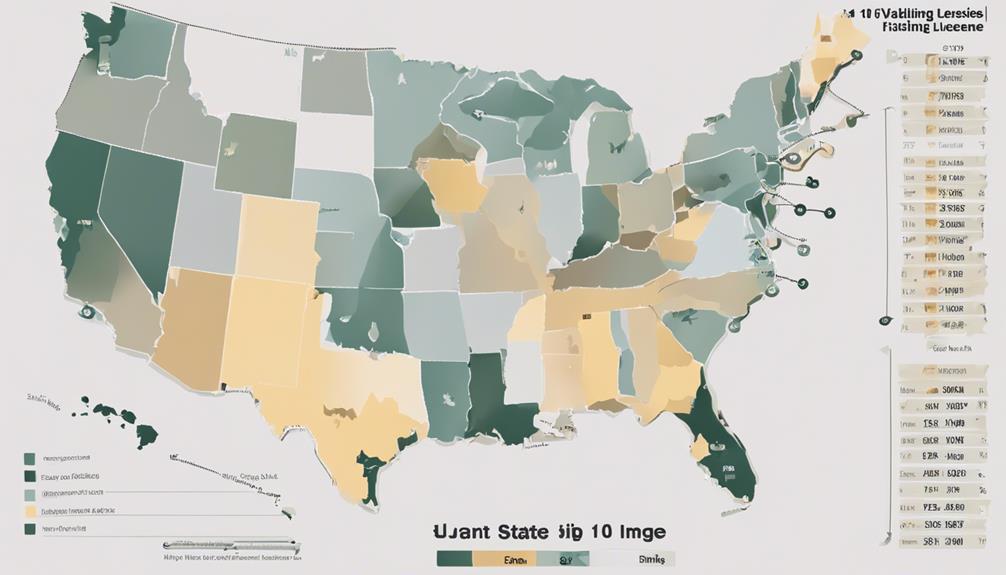Imagine a lake overrun by an invasive species, suffocating native fish populations and disrupting the ecosystem's delicate balance.
You're left pondering, what can be done to prevent such a scenario?
By employing three key strategies, we can mitigate the impact of invasive species on our waters.
From targeted regulations to collaborative efforts, the path to effective invasive species fishing control is multifaceted and intriguing.
Understanding Invasive Species Threats
To understand the threats posed by invasive species, you must recognize their potential to disrupt ecosystems and harm native wildlife. Preventing introductions of invasive species is crucial in safeguarding the balance of natural habitats. These intruders have the ability to outcompete native species for resources such as food and habitat, leading to a decline in biodiversity. Their rapid reproduction rates can overwhelm ecosystems, causing imbalances that ripple through the food chain. Invasive species can also introduce new diseases or parasites to native wildlife, further jeopardizing their survival.
The ecological impacts of invasive species can be far-reaching and long-lasting. They can alter the physical structure of habitats, such as wetlands or forests, by outcompeting native vegetation and changing the soil composition. These changes can have cascading effects on other species dependent on those habitats. In aquatic ecosystems, invasive species like zebra mussels can clog water intake pipes, disrupt food webs, and reduce water quality. This highlights the importance of vigilance in preventing the introduction of invasive species through measures such as strict biosecurity protocols and monitoring of trade and transportation routes.
Implementing Species-Specific Regulations
When implementing species-specific regulations, ensure strict enforcement to effectively manage the impact of invasive species on ecosystems. Data analysis plays a crucial role in identifying the most problematic invasive species in a particular region. By analyzing data on species distribution, reproduction rates, and ecological impacts, authorities can prioritize which species require targeted regulations to prevent further spread and damage.
Stakeholder engagement is key to the success of species-specific regulations. Involving local communities, fishermen, scientists, and conservationists in the decision-making process ensures that regulations are practical, effective, and well-received. Stakeholders often have valuable insights based on their experiences and knowledge of the local environment, which can help tailor regulations to specific needs and challenges.
Monitoring and Reporting Protocols
Consider establishing standardized monitoring and reporting protocols to track the effectiveness of invasive species fishing regulations. Data collection is crucial in assessing the impact of these regulations on invasive species populations and native ecosystems. By implementing consistent methods for collecting data on catch composition, fishing effort, and species abundance, regulatory bodies can better understand the outcomes of their management efforts.
Compliance tracking is another essential aspect of monitoring invasive species fishing regulations. It's important to ensure that anglers are following the rules set forth to protect native species and prevent the spread of invasive ones. By establishing reporting protocols that require anglers to provide information on their catches, locations, and fishing methods, authorities can monitor compliance and address any issues promptly.
Effective monitoring and reporting protocols not only help in evaluating the success of invasive species fishing regulations but also aid in making informed decisions for future management strategies. By analyzing the collected data and tracking compliance levels, authorities can adjust regulations as needed to achieve conservation goals effectively. Consistent monitoring also promotes transparency and accountability within the angling community, fostering a culture of responsible fishing practices that prioritize the preservation of native biodiversity.
Engaging Anglers in Conservation Efforts
Engage anglers in conservation efforts by fostering a sense of responsibility towards protecting native species and habitats. Angler outreach plays a crucial role in raising awareness about the negative impacts of invasive species on local ecosystems. By educating anglers on how their actions can either help prevent the spread of invasive species or contribute to their proliferation, you can empower them to become stewards of the environment.
Community involvement is another key aspect of engaging anglers in conservation efforts. Organizing community events, such as fishing tournaments focused on native species conservation, can't only promote responsible fishing practices but also foster a sense of camaraderie among anglers with shared conservation goals. By creating a supportive community that values the protection of native species and habitats, you can strengthen the commitment of anglers to conservation efforts.
Encouraging anglers to participate in habitat restoration projects can further solidify their connection to the environment. By actively involving anglers in initiatives aimed at restoring habitats affected by invasive species, you provide them with tangible ways to contribute to conservation efforts. This hands-on approach can instill a sense of pride and ownership in anglers, motivating them to continue supporting conservation initiatives in the future. By engaging anglers through outreach and community involvement, you can harness their passion for fishing to make a positive impact on native species and habitats.
Enforcing Strict Inspection Measures
To ensure effective management of invasive species, it's imperative to implement and uphold stringent inspection measures at all points of entry. Inspection efficiency is key to preventing the spread of harmful species. By utilizing advanced inspection technology such as DNA testing and underwater drones, enforcement effectiveness can be maximized. These tools allow for thorough inspections without causing significant delays to anglers.
Enforcement effectiveness is closely tied to compliance rates. When anglers are aware of the strict inspection measures in place, they're more likely to adhere to regulations. Regular inspections and visible enforcement presence can act as deterrents to those considering bypassing the rules.
Utilizing modern inspection technology not only enhances the efficiency of inspections but also provides valuable data for monitoring and adjusting enforcement strategies. By analyzing inspection data, authorities can identify trends, assess risks, and adapt their approaches to better tackle invasive species threats.
Strict inspection measures are crucial for safeguarding ecosystems from the damaging effects of invasive species. By prioritizing inspection efficiency, enforcement effectiveness, and high compliance rates, environmental agencies can significantly reduce the risks associated with invasive species introductions through fishing activities.
Collaborating With Environmental Agencies
Working in tandem with environmental agencies is pivotal in fortifying efforts to combat invasive species impact through fishing regulations. Collaborating with these agencies enhances regulatory compliance and fosters stakeholder engagement, which are essential components in the successful management of invasive species in water bodies.
Here are three key ways in which collaborating with environmental agencies can strengthen invasive species fishing regulations:
- Enhancing Regulatory Compliance: Environmental agencies play a crucial role in ensuring that fishing regulations are effectively enforced. By working together, agencies can streamline processes, share data, and coordinate efforts to monitor and enforce regulations aimed at preventing the spread of invasive species. This collaboration can help increase the overall effectiveness of fishing regulations in combating invasive species.
- Facilitating Stakeholder Engagement: Environmental agencies often serve as a bridge between regulatory bodies, fishing communities, and other stakeholders. By collaborating with these agencies, regulators can better understand the concerns and perspectives of various stakeholders, including anglers, conservation groups, and local communities. This engagement can lead to the development of more inclusive and effective fishing regulations that are supported by the community.
- Promoting Information Sharing: Environmental agencies are valuable sources of information and expertise on invasive species management. By partnering with these agencies, regulators can access valuable data, research, and best practices that can inform the development of evidence-based fishing regulations. This exchange of information can help regulators stay updated on the latest trends and technologies in invasive species management, ultimately leading to more effective regulations.
Educating the Public on Invasive Species

Educate the public on invasive species to raise awareness about their impact on ecosystems and the importance of prevention efforts. Public awareness plays a crucial role in combating the spread of invasive species. By educating individuals about the risks these species pose to native biodiversity, water quality, and overall ecosystem health, communities can work together to prevent their introduction and spread.
Community involvement is key in addressing the challenge of invasive species. Encouraging local residents, anglers, boaters, and other stakeholders to learn about invasive species and how to prevent their spread can significantly impact conservation efforts. Public awareness campaigns, workshops, and informational materials can help disseminate important information to a wide audience. By engaging the community in monitoring efforts and reporting sightings of invasive species, individuals play an active role in protecting their local environment.
Efforts to educate the public on invasive species should emphasize the role each person can play in preventing their spread. By understanding the pathways through which invasive species are introduced and taking simple steps to prevent their establishment, individuals can make a significant difference. Through community involvement and increased public awareness, we can work together to safeguard our ecosystems for future generations.
Evaluating the Effectiveness of Regulations
By assessing the impact of current fishing regulations on controlling the spread of invasive species, we can determine their effectiveness in protecting native ecosystems. Evaluating the effectiveness of regulations is crucial in ensuring that the measures put in place are achieving their intended goals.
Here are three key aspects to consider when evaluating the impact of fishing regulations on invasive species:
- Assessing Compliance Rates: One essential factor in determining the effectiveness of fishing regulations is the level of compliance among anglers and commercial fishermen. High compliance rates indicate that the regulations are being followed and are more likely to have a positive impact on controlling invasive species spread. Monitoring compliance through surveys, on-site inspections, and reporting mechanisms can provide valuable data to assess the effectiveness of the regulations.
- Measuring Ecological Impact: It's vital to evaluate how the fishing regulations are influencing the ecological balance within the native ecosystems. Monitoring changes in species diversity, population sizes, and habitat health can help determine if the regulations are effectively controlling invasive species and protecting the native biodiversity. Long-term ecological studies and scientific research can provide insights into the overall impact of the regulations on the ecosystem.
- Adapting Regulations Based on Evaluation: Regularly reviewing the effectiveness of fishing regulations allows for adjustments to be made based on evaluation results. If certain regulations are found to be ineffective or causing unintended consequences, modifications can be implemented to enhance their efficacy in controlling invasive species spread and safeguarding native ecosystems. Continual evaluation and adaptation are essential for maintaining the relevance and efficiency of fishing regulations in combating invasive species.
Frequently Asked Questions
How Do Invasive Species Impact Local Ecosystems and Native Species?
Invasive species wreak havoc on local ecosystems by outcompeting native species for resources. This leads to ecological impacts like biodiversity loss and disruptions in ecosystem health.
Native species, which have evolved to thrive in their habitats, suffer as invasive species alter the balance of the ecosystem. This disruption can have cascading effects on other species and the overall health of the ecosystem, highlighting the importance of addressing invasive species to protect native biodiversity.
What Are the Economic Costs Associated With Invasive Species in Fishing Industries?
When it comes to economic impacts caused by invasive species in fishing industries, you should consider the significant costs involved. These include losses in revenue, damage to equipment, and expenses related to control and eradication efforts.
Government policies play a crucial role in mitigating these costs by implementing regulations, monitoring programs, and supporting research. By addressing these challenges effectively, the fishing industry can better manage the economic impacts of invasive species.
Are There Any Potential Unintended Consequences of Implementing Strict Inspection Measures for Invasive Species?
When you implement strict inspection measures for invasive species, you may unintentionally disrupt the ecosystem balance. This can have adverse environmental impacts, affecting native species and habitats.
Additionally, such regulations may have policy implications, leading to challenges in international trade. It's essential to find a balance between preventing the spread of invasive species and considering the broader consequences on the environment and trade relationships.
How Can Recreational Anglers Help Prevent the Spread of Invasive Species?
To prevent the spread of invasive species, recreational anglers can make a big difference. Public awareness and education are key in understanding the threat. By cooperating with regulations and monitoring their equipment, anglers can help stop the spread of harmful species.
Stay informed, follow guidelines, and spread the word to other anglers. Your actions can have a significant impact in protecting our waterways from invasive species.
What Role Do Research and Data Collection Play in Improving Invasive Species Fishing Regulations?
Research impact is crucial for developing effective invasive species fishing regulations. By analyzing data collected in the field, policymakers can make informed decisions to protect native ecosystems.
Data collection benefits include identifying trends, understanding population dynamics, and assessing the impact of regulations. Research-driven regulations are more likely to be successful in managing invasive species populations and minimizing their spread.
Your involvement in data collection can directly influence the development of these regulations.
Conclusion
In conclusion, by implementing species-specific regulations, engaging anglers in conservation efforts, and collaborating with environmental agencies, you can effectively combat the threats posed by invasive species in fishing regulations.
Monitoring and enforcing strict inspection measures are crucial steps in protecting our ecosystems.
By educating the public on the importance of this issue and evaluating the effectiveness of regulations, we can work together to preserve our natural resources for future generations.



